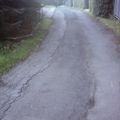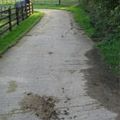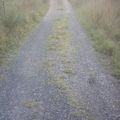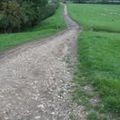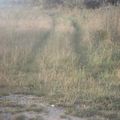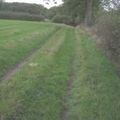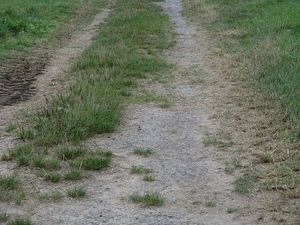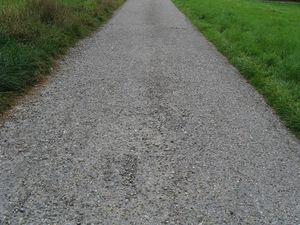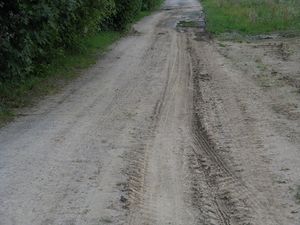Proposal:Surface values
| surface values | |
|---|---|
| Proposal status: | Abandoned (inactive) |
| Proposed by: | * |
| Tagging: | surface=gravel / dirt / broken / ice road / oiled gravel |
| Statistics: |
|
| Rendered as: | various |
Description 1
The surface values proposed feature extends the existing Key:surface key to include more values.
Current surface values
sealedunsealed- paved
- unpaved
- cobblestone
Recommended additional values
- user defined (already included by OSM tradition)
- dirt
- gravel
- broken
- ice road
Discussion
This is exactly what the tracktype is proposed for, but this is less suitable for all terrain, and less easy to sort out for rendering.
- If a person wants to be super speicfic for surfaces then the amount of variations of surfaces is rather large, and the data would just be inposible to manage. In the end the perpose of a map isn't to document the materials used, but instead help plan routes, or show what your will expect something to look like roughly, and for this reason anything more than classing the tracktypes is unnessesery in my opinion. Ben. 19:40, 21 March 2007 (UTC)
- I'd like to be able to map the surface as detailed as possible. Treeking bikers, MTBkers, inline skaters - they all depend on a certain quality of a track's surface. Of course we cannot render them all, but we're starting right now to see teh first routing applications, and routing is one of the main reasons why I'm contributing data to OSM. surface=paved and surface=unpaved is not enough IMO. Thus I'll support any effort that fills this gap --SlowRider 00:42, 30 April 2007 (BST)
- Its more the smoothness of the surface rather than the hardness of the surface that determins where a path is good enough for skating/boarding/riding down. So its not just the material, but rather how the material is layed. I.e. cement may be the smoothest thing you've ever riden, but it may also be like riding over corragated iron, or a grater. I think the answer to this and quite a few problems to do with peoples opinions on being able to tag differnet levels of detail, is to have 3 sets of values to some keys. In this case 1 person may just wish to split appart paved/unpaved. Another (like myself) would want to devide up the sufaces into 5 groups, and others may wish to have a different tag for each material. But either having none or extremly exact detail isn't the way to go, because the majourity of people will just go for having none, and surfaces won't be added at all. Either that or there will be a lot of inacurate guess work. If this proposal, tracktypes, and just paved/unpaved (I think this needs better wording) are all under 1 key, then I would agree to this. Ben 18:29, 30 April 2007 (BST)
- Extending surface=paved/unpaved slightly to include a small set of values proposed in the preamble is useful for route-planning an d recognition purposes and will get my vote. As a cyclist, I might well avoid a paved cobbled road but go for an unpaved gravel road while avoiding the unpaved dirt road. As a hiker, looking out for a gravelled path is much more descriptive than just an unpaved path. MikeCollinson 18:20, 7 June 2007 (BST)
- I'd like to also see "boardwalk" or "board" or some such. --Hawke 03:20, 10 June 2007 (BST)
- "boardwalk" or "board" seems to be a value for the "highway" key.--OnTour 21:11, 16 June 2007 (BST)
- Hardly. Boardwalk can be footway, cycleway, and I'm sure there's some automobile and horse roads that could be considered boardwalk as well.
Description 2
This chapter is not static. This chapter may be modified by everyone. With the reason that it must be possible to follow a discussion, please, use the strike tag (strike) if you delete words in this chapter.
The feature "surface" should have only the values paved and unpaved. This is easyer for a first crude characterization of a way for everyone . After this, the ways may be characterized with more details. Two additional properties should be used. One for the crude quality and one for the material quality. Other pictures with special requirements are desired and everyone is asked to find a good description for this.
surface_macro
- plane
- wave (wavy)
- hole (holey)
- soft (softly)
- rough
surface_micro
- smooth (concrete, asphalt)
- sand (sandy)
- stone (stony)
- plant (grass)
ice
I suggest:
surface = paved|unpaved
surface_state = smooth|plane|wave|holey|soft|rough|...
surface_material = asphalt_concrete|brick|cobblestone|concrete|corduroy|dirt|gravel|ice|macadam|bitumen|plank|plant|soil|tarmac|...
| Situation | surface | surface_state | surface_material |
|---|---|---|---|
| paved | wave | smooth | |
| paved | plane | smooth | |
| unpaved | plane | sand | |
| unpaved | plane | stone | |
| unpaved | wave | plant | |
| unpaved | wave | plant |
Discussion
I agree with description 2 and am in favour to minimize the number of 'values' of surface. But I suggest paved/half paved/unpaved, most pathes/roads (at least in NL) fit into 'half paved'. I think it's a good idea to organize extra attributes on the special demands a special use asks from a way. Maybe name a tag on this special use like skating_surface and values terrible/bad/normal/good/excellent. The values for mountainbike_surface are probably exactly opposite to the values of skating_surface ;) rvanderh, 3 August 2007
- I think it's would be better to categorize it in "surface_state" and "surface_material"Cbm 20:11, 14 December 2007 (UTC)
- I also like the approach but still miss something to describe things like potholes, puddles, large cracks in the concrete and so on. Would't surface_state=smooth be good in addition for explicitly marking roads plane enough for skates and racing bikes?
- Here is my point of vue on the tracktype/surface problem :
Proposed_features/grade1-5#the_solution_of_using_the_surface_tag_is_not_enough
In short I think we should spit the problem in two :
- one tag for the surface of the road/track/path if that matter for skates, rollers, bikes, Lawn mowers
- one other tag to describe wich vehicule can drive on ( which to my opinion is the more important )
As I explain on my link, the type of surface is not enough to tell wether your car can drive on it or not
( think of mountain trails ) Sletuffe 16:18, 11 March 2008 (UTC)
- I completely agree with description 2 and would like to add surface_material=cobblestone.
- I agree that what we should care about most is the usability of a way for a given mode of transport in wheeled vehicles. And if I am not forgetting something important, I think it would be enough to have five categories:
| Proposal | surface | rollers=skates | racing bikes | city bikes = sports cars | trekking bikes = normal cars | mountain bikes = 4wd |
|---|---|---|---|---|---|---|
| smoothness=excellent | smooth | yes | yes | yes | yes | yes |
| smoothness=good | rough asphalt | yes | yes | yes | yes | |
| smoothness=intermediate | cobblestone or unpaved, but compressed and plane | yes | yes | yes | ||
| smoothness=bad | unpaved, wave but compact, grass | yes | yes | |||
| smoothness=catastrophic | rough, dirt, mud, loose gravel, sand | yes |
I am not sure yet what key and what values to use, but I think this should be enough as the number of values goes. If there is some wheeled vehicle that cannot live with being classified together with one of the vehicles in the head row, please let me know. The decision wether a way belongs to a particular category should not be made based on the description of the surface (there will always something be missing), but based on the usability for the given vehicles. More detailed classification should IMHO go into a different key (like surface_material). --Chrischan 14:05, 12 March 2008 (UTC)
- I completly agree with your table, looks good and enough to me. But what is your idea for tagging it ?
surface=paved/unpaved/rollers/city_bike/trekking_bike/mountain_bike ? Sletuffe 20:08, 12 March 2008 (UTC)
- I added a proposal for tagging it. I think it should be called "smoothness" ("Laufruhe" in german), because this is what we are measuring: How calm can a wheel roll on this surface. Thus, we dont interfere with the surface stuff and it can be deprecated later on. I tried to classify every way I rode on last week, and I still think this is a good classification. --Chrischan 10:14, 18 March 2008 (UTC)
- actually the "smoothness" of a road with highway=* and cycleway=track and footway=track is meant for the road itself and not the footway/cycleway of the road. This would result in the need of three surface-tags. If the result for the surface-tag is the information for skate-able and racebike-able roads then I would prefer the tags skateable=excelent,medium,difficult,no and leave the surface-tag as simple as it is now. This would result in no change for the most roads and changes for only the roads that are used by racebike-riders and inline-skaters. --P.J. 16:28, 17 April 2008 (UTC)
- This has been proposed several times, but I still think it is not a good idea. For a theoretically infinite number of wheeled vehicles you need an infinite number of tags (wheelchair = ..., buggy = ..., lawn mower = ..., sports car = ..., racing bike = ...). "Smoothness" of a way is a physical property and its valuable information on its own. Please note that I DO NOT propose to extend the surface tag, as you imply. The argument that the tag applies to the road (and not to the cyclelane) is valid, but this applies as well to the surface tag and to all other tags of physical property for that matter. What if the road is paved but the cyclelane is not? So that is a problem of combining several ways into one, and I have no solution for that. I still think that "smoothness" is a good idea. --Chrischan 20:39, 28 April 2008 (UTC)
- The solution ist to introduce a new notation for things left and right of the road: <tag left.cycleway.smoothness=excellent>--JochenB 22:46, 19 June 2008 (UTC)
- This has been proposed several times, but I still think it is not a good idea. For a theoretically infinite number of wheeled vehicles you need an infinite number of tags (wheelchair = ..., buggy = ..., lawn mower = ..., sports car = ..., racing bike = ...). "Smoothness" of a way is a physical property and its valuable information on its own. Please note that I DO NOT propose to extend the surface tag, as you imply. The argument that the tag applies to the road (and not to the cyclelane) is valid, but this applies as well to the surface tag and to all other tags of physical property for that matter. What if the road is paved but the cyclelane is not? So that is a problem of combining several ways into one, and I have no solution for that. I still think that "smoothness" is a good idea. --Chrischan 20:39, 28 April 2008 (UTC)
- actually the "smoothness" of a road with highway=* and cycleway=track and footway=track is meant for the road itself and not the footway/cycleway of the road. This would result in the need of three surface-tags. If the result for the surface-tag is the information for skate-able and racebike-able roads then I would prefer the tags skateable=excelent,medium,difficult,no and leave the surface-tag as simple as it is now. This would result in no change for the most roads and changes for only the roads that are used by racebike-riders and inline-skaters. --P.J. 16:28, 17 April 2008 (UTC)
- If a cycle lane really is a cycle lane, doesn´t it have the same surface as the road then? And if not, isn´t it correct to deal with it as a separe track at the side of the road? --Henriko 00:07, 5 May 2009 (UTC)
- I agree as well. This differentiation should be inough to qualify even tracks for speedskates, and, in the opposite, find ways where it is possible to ride continuous. --klappschlauch 01:00, 2 April 2008 (UTC)
- I think that a value for a roads suitablility for skates shoud be an own tag like "skatetype=excelent/good/intermediate " than with surface-values because the suitability for skates is not only determined by the surface but also by traffic. (And nobody would tag a motorway skateable or suitable for racing bikes only because of its surface) --P.J. 08:22, 16 April 2008 (UTC)
- I would say "skatetype" could be an additional tag, althoug it is somewhat possible to derive it from other properties ("smoothness" and highway type). "Smoothness" however is of much broader interest (in my opinion). It is needed for racing bikes, wheelchairs and many others. --Chrischan 20:39, 28 April 2008 (UTC)
- I think that a value for a roads suitablility for skates shoud be an own tag like "skatetype=excelent/good/intermediate " than with surface-values because the suitability for skates is not only determined by the surface but also by traffic. (And nobody would tag a motorway skateable or suitable for racing bikes only because of its surface) --P.J. 08:22, 16 April 2008 (UTC)
- Looks like you've created a proposal for the Proposed features/Smoothness tag, I'll jump to it to help finish it and start using it.
Sletuffe 16:24, 16 May 2008 (UTC)
- Wouldn't it be more appropriate to directly use the access-tag to mark whether a certain vehicle is able to use a particular road/track, e.g. access=high_clearance or access=4WD? To me this seems to be more straightforward than using a smoothness value. See: Talk:Key:access#Technical_instead_of_legal_access_restrictions -- Ukuester 08:36, 3 July 2008 (UTC)
- I'm a hiker mapping hiking trails and I think that surface_material should be wider to cover foot users expectatives (in order to plan a route). What do you think about a classification based on size:
- Mud < 0.06 mm
- Sand 0.06-2 mm
- Gravel 2-63 mm
- Cobble 64-256 mm
- Boulder >256 mm
Expanded with:
- dirt - a mixture of diferent particle sizes (mud+sand+gravel, for example)
- soil - the same but with organic matter
- rock - solid and hard surface, with no particles.
Surfaces for large areas
e.g. see Proposed features/Water cover, which uses surface to describe beaches, mud-flats, etc.
Mixed surfaces
What about surfaces that have mixed materials, such as:
| Gravel and dirt, with grass in the middle | |
| Paved (concrete I guess?), but with enough gravel or grit to make you slide a bit | |
| Gravel and dirt, with more dirt and even water on the right |
Mixed surfaces as in Example 2 could be tagged as surface_material=concrete;grit, with the first value being the most dominant material on the way. Of course programs that use the data would have to know that it can have more than one value. But what about ways that have different surfaces on the left/middle/right part of the way? What would you tag in the examples above? --Driver2 16:36, 18 August 2008 (UTC)
Abstraction from tracks
I like this proposal because it have a possibility to be useful. Only if you people would a bit abstract from tracks and try to generalise. The surface problem is not restricted to tracks, as highways often have "smoothness" values around "bad", "scary sh*t" or "life in danger". :-) So I would very much like if this proposal would be useful for highways too. I have tried a mildly stupid idea to propose just to make it somehow possible to signal to people and to navigation software that a highway should be avoided if possible. (Yes, we have highway=secondary with smoothness=bad around.)
So I believe these are the points to consider:
- have as few attributes as possible (makes easier to use by software)
- make attributes as abstract as possible (Highway, Cycleway, Tracktype, Aeroway should use them)
- make it possible to give enough information to make educated guesses on the possible usage and maximal speed on the way
I like the following proposed:
- surface = paved / unpaved
- surface_state = excellent / good / average [intermediate too long for me :)] / bad / very bad
- surface_material = asphalt / stone / sirt / ice / whatever you please
But I would extend the table of the meaning of the states, something like
| state | description |
|---|---|
| excellent | (smooth) smooth surface, like newly made highway, cycleway, compact footway, etc. |
| good | the normal worn-and-used state of ways, some bumps and cracks as normal |
| average | (wave) as highway/cycleway: patched and a bit cracked, corners may be degraded, starts to limit maximally possible speed; as track, it have smaller bumps and holes; generally a way which could use some fixing, but still pretty useable |
| bad | (rough, holey) as highway: broken surface, holes, cracks, corners broken, surface sink or raised, wavy; as track it shows definite wear, holes, or other surface problems (mud, water-craved little holes, etc); either case it severely needs fixing up, definitely limits usage by faster vehicles (or fast feet ;)) |
| very bad | really broken, like a paved highway with large unpaved parts, or stone road with large dirt/mud patches, big holes, etc; cars cannot go faster than 40Km/h as highway, and as a footway running people may broke their ankles. Generally it's been some official's joke to call this road "highway" or "track". Needs rebuild. |
IMHO. --grin ✎ 11:38, 22 August 2008 (UTC)
- Which proposal are you talking about ? surface=* or the smoothness=* ?
- Seams you are talking about smoothness=* ? then why not move there to discuss ?
- If you are talking about surface=* then I don't agree, "surface" like it's name suggest talks about "surface" not "surface in a purpose to drive" Sletuffe 14:18, 22 August 2008 (UTC)
Because smoothness proposal seemed to be unlinked to the material of the road, and a "good" dirt road would be classified there "bad" because you cannot drive a Ferrari at 250Km/h on it. But thank you for the tip, I copied over there. Bye then here. --grin ✎ 10:59, 23 August 2008 (UTC)
In some areas, the smoothness of the road might vary over time, for instance roads that are submerged on high tide, or areas with ice boaring in the road. The road will be smooth when maintenance have been done, but water-trenches and potholes might appear at any time. Such roads are generally maintained on a regular basis, and therefor hard to define as smooth or bumpy. --Skippern 01:27, 8 September 2008 (UTC)
